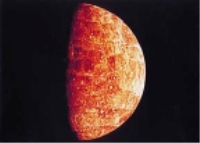

Currently,
Mercury has an almost negligible atmosphere - only a few billionths of the
density of the Earth's. The atmosphere consists maily of sodium vapour, perhaps
ejected from the surface by meteorite impacts. There are also small amounts of
helium and hydrogen from the solar wind. As for the body of Mercury itself, data
from the Mariner 10 spacecraft indicate that this small planet has an
unexpectedly large metallic core (probably based on iron) and a rocky crust.
Mercury
is much nearer to the Sun than the Earth is, and travels in an elliptical orbit.
It is normally too close to the Sun to be easily seen from the Earth. Even when
it is visible, it is not far above the horizon - so the light coming from
Mercury has to pass obliquely through the Earth's atmosphere and it is
impossible to obtain a clear image. Also, Mercury's surface is made of dark
material and reflects only 6% of the sunlight that falls on it. From infrared
observations, we believe that the surface is covered in fine dust.
Our
knowledge of Mercury was very sketchy until 1974, when the American space probe,
Mariner 10, photographed the surface. It passed as close as 300 km above Mercury
and the on-board TV cameras took some 4 000 pictures which were transmitted to
Earth. The Mariner picture (right) show a large meteorite crater called the
Caloris Basin, covering nearly one tenth of the planet's surface. Another
feature that stands out is lines of cliffs (scarps) hundreds of kilometres long.
Physical Data:
Diameter: 4 878
km
Temperature: -173 degrees Centigrade to 425 degrees Centigrade
Minimum distance from Earth: 91.7 million km
Distance from Sun: 45.9 to 69.7 million km
Period of rotation: 58days 15hours
Period of orbit: 88 days
Number of moons: nil